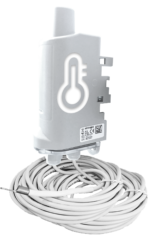Legionella
What does the regulation say?
What does the regulation say?
Legionellosis is a respiratory infection caused by a bacterium of the legionella family.
The infection is caused by inhalation of contaminated water in the form of aerosols or droplets.
This bacterium develops in fresh and stagnant water with a temperature between 25 and 45°C.
Santé publique France, indicates that over the last 5 years:
11 à 13%
cases of legionellosis have been linked to visits to hotels and tourist residences and campsites.
6 à 8%
are related to the use of health facilities.
4 à 5%
are linked to the use of social and medico-social institutions for the elderly (EHPAD).
In order to limit the risks, it is therefore necessary to maintain the temperature of the water at at least 55°C, between the point of distribution and the point of use. This is the threshold below which legionella proliferates in the event of contamination.
The development of this bacterium in Domestic Hot Water (DHW) systems can be the result of several factors:
In order to fight against the proliferation of the deadly legionella bacteria, the french law imposes since 2010 (decree of February 1st, 2010) a strict control of the temperature in domestic hot water networks (DHW), in all the Health Establishments (Hospitals, EHPAD) and Establishments Receiving Public (ERP).
All these establishments are therefore legally obliged to take measures to monitor and control the DHW networks in order to act as quickly as possible in the event of detection of non-compliance with the temperature thresholds to be checked.

Health establishment

EHPAD, Retirement homes

Hotels / Leisure

Schools

Other ERP
The establishments concerned are those with a collective distribution of DHW and those that expose the public to water use points that emit aerosols that can disperse legionella:
Find the complete list in the circular Circulaire DGS/EA4 no 2010-448 of 21 December 2010 (pages 5-6).
The most risky installations are showers in hotels, tourist residences and campsites, spas, thermal baths, cooling towers used for air conditioning and collective misting systems (outdoor showers, fountains, etc.).
The control is carried out on a regular basis according to the following rhythm (source: Guide technique de l’ARS):
Monitoring points
Mandatory measures
Monitoring points
Outlet for domestic hot water production(s) (distribution)
Mandatory measures
Water temperature: once a month
Monitoring points
Bottom of hot water production and storage tank(s)
Mandatory measures
Legionella analysis: once a year
– in the last tank if the tanks are installed in series
– in one of them if the tanks are installed in parallel
Monitoring points
Most representative point(s) of use in the network or, failing that, the point(s) of use furthest from the domestic water production
Mandatory measures
Legionella analysis: once a year
Water temperature: once a month
Monitoring points
Loop return (general return) if applicable
Mandatory measures
Legionella analysis: once a year
Water temperature: once a month for each loop

Discover our IoT sensor TEMP2S , dedicated to temperature monitoring, it allows you to automatically control the temperature of your hot water networks without having to move.
02/03/2022
expertise to support you, from the diagnosis to the implementation of your solution
Subscribe to our newsletter!
Your e-mail address is only used to send you our newsletter and information about our company. You can unsubscribe at any time using the link included in each email.
